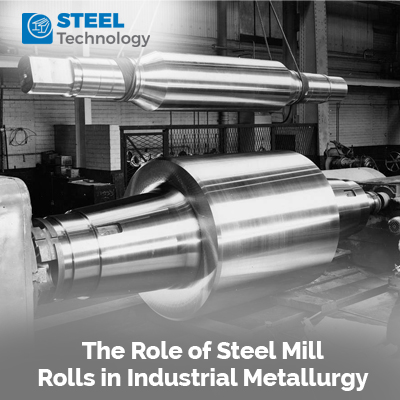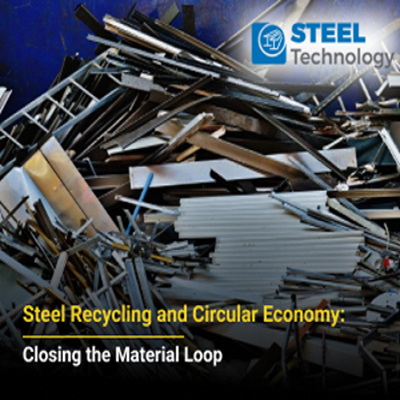The Role of Steel Mill Rolls in Industrial Metallurgy

Importance of Steel Mill Rolls in Industrial Metallurgy
Steel mill rolls are an integral component of the industrial metallurgy process. These rolls play a crucial role in shaping and forming steel products, enabling the transformation of raw materials into the wide array of end products we use in our everyday lives. Without steel mill rolls, the steel industry would not be able to achieve the level of precision and efficiency required for optimal production.
In the world of steel manufacturing, hot-rolling and cold-rolling processes are used to shape and form steel. The function of steel mill rolls varies depending on the specific process. In hot rolling, steel mill rolls are used to reduce the thickness of steel slabs or billets while increasing their length. This process involves applying enormous pressure and heat to the steel, and the rolls must be able to withstand these extreme conditions. Cold rolling, on the other hand, involves passing steel through a series of rolls to achieve the desired thickness, surface finish, and dimensional accuracy.
Steel mill rolls are designed to withstand the rigors of repetitive use and extreme conditions. They are made from high-quality materials such as forged steel, cast steel, or even tungsten carbide, which offer exceptional strength, durability, and resistance to wear and tear. These rolls are engineered to deliver consistent results, ensuring that the steel products meet the required specifications. The precision and reliability of steel mill rolls are crucial in maintaining the productivity and quality standards of the steel industry.
I. Types of Steel Mill Rolls
Steel mill rolls come in various types, each designed for specific applications and processes. The choice of roll type depends on factors such as the type of steel being processed, the desired product characteristics, and the operating conditions in the steel mill.
Work Rolls: Work rolls are the primary rolls used in the rolling process. They come in different configurations, such as flat, grooved, or profiled, depending on the requirements of the specific rolling operation. Work rolls are responsible for applying pressure to the steel, shaping it into the desired form, and reducing its thickness.
Back-up Rolls: Back-up rolls provide support to the work rolls and help maintain their shape and position during the rolling process. These rolls are larger in size and often made from materials with high strength and toughness to withstand the load and pressure applied by the work rolls.
Intermediate Rolls: Intermediate rolls are used in certain rolling operations to support the work rolls and ensure proper alignment. These rolls are positioned between the work rolls and backup rolls and help distribute the pressure evenly across the work rolls.
Sendzimir Rolls: Sendzimir rolls, also known as cluster mill rolls, are used in a specific type of rolling mill called a Sendzimir mill. These rolls are characterized by their small diameter and the ability to adjust the roll gap during the rolling process. Sendzimir rolls are commonly used in the production of high-quality steel with precise thickness and surface finish.
Leveler Rolls: Leveler rolls are used in the leveling process, which is a crucial step in achieving the desired flatness and uniform thickness of steel sheets. These rolls apply pressure to the steel as it passes through the leveling machine, correcting any imperfections and ensuring a smooth and even surface.
Each type of steel mill roll serves a specific purpose and contributes to the overall efficiency and quality of the steel manufacturing process. The selection of the right type of roll is essential to optimize production and achieve the desired product characteristics.
II. Manufacturing Process of Steel Mill Rolls
The manufacturing process of steel mill rolls involves several steps, each aimed at producing rolls with the required properties and characteristics. The process starts with the selection of suitable materials, followed by the shaping and heat treatment of the rolls.
Material Selection: The choice of material depends on factors such as the type of rolling process, the operating conditions, and the desired roll performance. Common materials used for steel mill rolls include forged steel, cast steel, and tungsten carbide. Each material has its advantages and limitations, and the selection is made based on the specific requirements of the application.
Shaping: Once the material is selected, it is shaped into the desired roll form. This can be done through various methods, including forging, casting, or machining. Forging involves shaping the material through the application of heat and pressure, resulting in a strong and durable roll. Casting, on the other hand, involves pouring molten metal into a mold to create the desired shape. Machining is used to refine the shape and dimensions of the roll, ensuring its accuracy and precision.
Heat Treatment: Heat treatment is an essential step in the manufacturing process, as it helps enhance the mechanical properties of the roll. The heat treatment process involves heating the roll to a specific temperature and then cooling it rapidly or slowly, depending on the desired properties. Heat treatment can improve the hardness, strength, and wear resistance of the roll, ensuring its longevity and performance.
Finishing: After heat treatment, the rolls undergo various finishing processes to achieve the desired surface finish and dimensional accuracy. These processes include grinding, polishing, and coating. Grinding helps remove any imperfections and ensures a smooth surface, while polishing enhances the roll's appearance. Coating, such as chrome plating, can be applied to improve the roll's corrosion resistance and reduce friction during the rolling process.
The manufacturing process of steel mill rolls requires precision and expertise to ensure the production of high-quality rolls that can withstand the demanding conditions of the steel industry.
III. Properties and Characteristics of Steel Mill Rolls
Steel mill rolls possess several properties and characteristics that make them suitable for their role in industrial metallurgy. These properties contribute to the overall performance and durability of the rolls, allowing them to withstand the harsh conditions of the rolling process.
Hardness: Steel mill rolls need to be sufficiently hard to withstand the pressure and wear encountered during rolling. The hardness of the rolls is achieved through appropriate material selection and heat treatment. A high degree of hardness ensures that the rolls can resist deformation and maintain their shape, resulting in accurate and consistent steel products.
Strength: The strength of steel mill rolls is crucial for their ability to withstand the enormous forces exerted during the rolling process. Strong rolls can withstand the pressure and prevent deformation, ensuring the desired shape and thickness of the steel. The strength of the rolls is influenced by factors such as the material composition, heat treatment, and manufacturing process.
Wear Resistance: Steel mill rolls are subject to continuous wear due to the friction and pressure involved in the rolling process. Therefore, they need to have excellent wear resistance to maintain their performance over time. Materials such as tungsten carbide are known for their exceptional wear resistance, making them suitable for demanding rolling applications.
Toughness: Toughness is another important characteristic of steel mill rolls. It refers to the ability of the rolls to absorb energy without fracturing or breaking. Tough rolls can withstand the impact and shock loads encountered during the rolling process, ensuring their longevity and reliability.
Dimensional Stability: Steel mill rolls need to maintain their dimensional stability to ensure the accuracy and precision of the rolling process. The rolls must resist deformation and maintain their shape and dimensions under the high pressures and temperatures encountered during rolling. Dimensional stability is achieved through appropriate material selection, heat treatment, and manufacturing techniques.
The properties and characteristics of steel mill rolls are carefully engineered to meet the demanding requirements of industrial metallurgy. By possessing these qualities, the rolls contribute to the overall efficiency, productivity, and quality of the steel manufacturing process.
IV. Common Issues and Challenges in Steel Mill Roll Usage
While steel mill rolls are designed to withstand the rigors of the rolling process, they are not immune to issues and challenges. The demanding conditions and repetitive use can lead to various problems that affect the performance and lifespan of the rolls.
Wear and Tear: Steel mill rolls are subject to continuous wear due to the friction and pressure involved in the rolling process. Over time, this wear can lead to a decrease in roll diameter, surface roughness, and dimensional accuracy. Excessive wear can result in reduced product quality, increased downtime, and higher maintenance costs.
Roll Breakage: The high forces and pressures exerted on steel mill rolls can sometimes lead to roll breakage. This can occur due to factors such as material defects, fatigue, or improper usage. Roll breakage can disrupt the production process, cause damage to other equipment, and result in unplanned downtime.
Chatter Marks: Chatter marks are periodic marks or ripples that appear on the surface of rolled steel products. They are caused by vibrations in the rolling mill, which can be attributed to various factors such as improper roll alignment, inadequate roll stiffness, or excessive rolling speed. Chatter marks can negatively impact the surface finish and dimensional accuracy of the steel products.
Roll Surface Degradation: The surface of steel mill rolls can degrade over time due to factors such as oxidation, corrosion, or the accumulation of contaminants. A degraded roll surface can negatively affect the quality of the rolled steel, leading to surface defects or reduced product performance.
Roll Cooling Challenges: Steel mill rolls generate significant heat during the rolling process, and effective cooling is crucial to prevent overheating and ensure the desired product characteristics. However, achieving optimal roll cooling can be challenging due to factors such as the roll's complex geometry, limited cooling capacity, or inadequate cooling system design.
Addressing these issues and challenges requires proactive maintenance, regular inspections, and the implementation of appropriate solutions. By identifying and resolving these issues, the performance and lifespan of steel mill rolls can be optimized, leading to improved productivity and product quality.
V. Maintenance and Care for Steel Mill Rolls
Proper maintenance and care are essential to maximize the performance and lifespan of steel mill rolls. Regular maintenance practices and effective care routines can help prevent issues and extend the service life of the rolls.
Inspections: Regular inspections of steel mill rolls are crucial to identify any signs of wear, damage, or other issues. Inspections should include visual examinations, measurements, and non-destructive testing techniques to assess the condition of the rolls accurately. Early detection of problems allows for timely repairs or replacements, minimizing downtime and maintaining product quality.
Cleaning: Cleaning the rolls is an important maintenance practice to remove contaminants and prevent surface degradation. The cleaning process may involve using specialized cleaning agents or equipment to ensure thorough cleaning without causing any damage to the rolls. Regular cleaning helps maintain the surface finish and performance of the rolls.
Lubrication: Proper lubrication of steel mill rolls is essential to reduce friction and wear during the rolling process. Lubricants help minimize the contact between the rolls and the steel, reducing the risk of surface damage and improving the overall performance of the rolls. The choice of lubricant depends on factors such as the roll material, operating conditions, and specific rolling process.
Roll Grinding and Maintenance: Roll grinding is a maintenance practice that involves removing a small amount of material from the roll surface to restore its shape, dimensions, and surface finish. This process helps eliminate any imperfections or damages that may affect the performance of the rolls. Regular roll grinding can improve the lifespan and performance of steel mill rolls.
Optimized Cooling: Effective roll cooling is crucial to prevent overheating and maintain the desired product characteristics. Optimizing the cooling system involves ensuring proper water flow, temperature control, and distribution across the roll surface. Adequate cooling helps prevent roll surface degradation and extends the service life of the rolls.
By implementing a comprehensive maintenance and care routine, steel mill rolls can perform optimally, resulting in improved productivity, reduced downtime, and enhanced product quality.
VI. Advancements in Steel Mill Roll Technology
The steel industry is continuously evolving, and advancements in technology have led to the development of innovative solutions and improvements in steel mill roll technology. These advancements aim to enhance the performance, durability, and efficiency of steel mill rolls, further optimizing the steel manufacturing process.
Advanced Materials: The development of new materials, such as high-speed steel or composite materials, has expanded the range of options available for steel mill rolls. Advanced materials offer improved properties such as higher hardness, better wear resistance, and increased toughness, allowing for enhanced roll performance and longevity.
Surface Coatings: The application of advanced surface coatings to steel mill rolls has become increasingly common. Coatings such as chrome plating or diamond-like carbon coatings can improve the roll's surface hardness, wear resistance, and corrosion resistance. These coatings help extend the service life of the rolls and enhance their performance in demanding rolling applications.
Roll Design Optimization: Advances in computer-aided design (CAD) and simulation technologies have allowed for the optimization of roll designs. The use of advanced software tools enables engineers to analyze the stresses, strains, and other factors affecting the performance of steel mill rolls. This optimization process helps create rolls with improved strength, durability, and performance.
Sensor Technology: The integration of sensor technology into steel mill rolls allows for real-time monitoring of various parameters, such as temperature, vibration, or roll alignment. Sensor data can provide valuable insights into the condition of the rolls, allowing for proactive maintenance and timely interventions to prevent issues or failures.
Smart Roll Systems: The concept of smart roll systems is gaining traction in the steel industry. These systems utilize sensors, automation, and data analysis to optimize the performance of steel mill rolls. Smart roll systems can provide real-time information on roll conditions, performance, and maintenance needs, enabling proactive decision-making and improved overall efficiency.
Advancements in steel mill roll technology continue to drive innovation in the steel industry. These advancements contribute to the overall improvement of the steel manufacturing process, ensuring higher productivity, better product quality, and reduced maintenance costs.
VII. Leading Manufacturers of Steel Mill Rolls
Several manufacturers specialize in the production of steel mill rolls, offering a wide range of roll types and solutions tailored to the specific needs of the steel industry. These manufacturers combine expertise, innovative technologies, and high-quality materials to produce rolls that meet the demanding requirements of industrial metallurgy.
Xtek, Inc.: Xtek is a leading manufacturer of custom-engineered steel mill rolls, providing solutions for hot and cold rolling applications. The company offers a wide range of roll types, including work rolls, back-up rolls, and sendzimir rolls. Xtek's rolls are known for their exceptional performance, durability, and resistance to wear and tear.
Union Electric Åkers: Union Electric Åkers is a global leader in the production of steel mill rolls, serving various industries, including steel, aluminum, and copper. The company's rolls are renowned for their quality,
Conclusion:
In conclusion, steel mill rolls are indispensable in industrial metallurgy, playing a crucial role in shaping and forming steel products through processes like hot rolling and cold rolling. They come in various types such as work rolls, back-up rolls, intermediate rolls, Sendzimir rolls, and leveler rolls, each serving specific purposes in the rolling operations. The manufacturing process involves material selection, shaping, heat treatment, and finishing to ensure high-quality rolls with properties like hardness, strength, wear resistance, toughness, and dimensional stability.
Despite their importance, steel mill rolls face challenges such as wear and tear, roll breakage, chatter marks, surface degradation, and cooling issues. Proper maintenance practices including inspections, cleaning, lubrication, roll grinding, and optimized cooling are essential to maximize their performance and lifespan.
Advancements in steel mill roll technology, such as the use of advanced materials, surface coatings, optimized designs, sensor technology, and smart roll systems, continue to improve roll performance, durability, and efficiency. Leading manufacturers like Xtek, Inc., and Union Electric Åkers are at the forefront of producing high-quality steel mill rolls for various industrial applications, contributing to the overall advancement of the steel manufacturing process.











